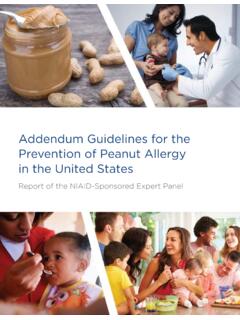Transcription of National Institutes of Health (NIH) Funding: FY1996-FY2022
1 National Institutes of Health (NIH) Funding: FY1996-FY2022 Updated June 29, 2021 Congressional Research Service R43341 Congressional Research Service SUMMARY National Institutes of Health (NIH) Funding: FY1996-FY2022 This report details the National Institutes of Health (NIH) budget and appropriations process with a focus on FY2020, FY2021, and FY2022. Coronavirus supplemental funding for NIH is discussed in a dedicated section of the report but is generally not included in the budgetary figures elsewhere in the report. The report also provides an overview of funding trends in regular appropriations to the agency from FY1996 to FY2022. Appendix A includes funding tables by account and program-specific funding levels for FY2020, FY2021, and FY2022. Appendix B provides a list of acronyms and abbreviations used in the report. NIH is the primary federal agency charged with conducting and supporting medical, Health , and behavioral research, and it is made up of 27 Institutes and Centers and the Office of the Director (OD).
2 About 80% of the NIH budget funds extramural research through grants, contracts, and other awards. About 10% of NIH funding goes to intramural researchers at NIH-operated facilities. Almost all of NIH s funding is provided in the annual Departments of Labor, Health and Human Services, and Education, and Related Agencies (LHHS) Appropriations Act. NIH also receives smaller amounts of funding from Interior/Environmental (INT) appropriations and a mandatory budget authority for type 1 diabetes research. The FY2021 NIH program level of $ billion represents a $ billion increase (+ ) above the FY2020-enacted program level. The FY2021-enacted total for NIH is also $ billion (+ ) above the FY2021 budget request and $715 million (+ ) above the program level proposed by the House-passed LHHS and INT bills. In FY2021, all institute and Center (IC) accounts received an increase above FY2020 funding levels, except for the Buildings and Facilities account (see Table A-1). The Biden Administration s FY2022 budget request proposes an FY2022 program level of $ billion a $ billion increase (+ ) from the FY2021 program level.
3 It also proposes the creation of a new Advanced Research Projects Agency for Health (ARPA-H) within NIH. NIH has seen periods of high and low funding growth during the period covered by this report, as illustrated in Figure 1. Between FY1996 and FY1998, funding for NIH grew from $ billion to $ billion (nominal dollars). Over the next five years, Congress and the President doubled the NIH budget to $ billion in FY2003. In each of FY1999 through FY2003, NIH received annual funding increases of 14% to 16%. From FY2003 to FY2015, NIH funding increased more gradually in nominal dollars. In some years (FY2006, FY2011, and FY2013), funding for the agency decreased in nominal dollars. From FY2016 through FY2020, NIH has seen funding increases of over 5% each year. The largest increase was from FY2017 to FY2018, where the program level increased by $ billion (+ ), making this the largest single-year nominal dollar increase since FY2003. The proposed funding increase in the FY2022 budget request would be over twice this amount.
4 When looking at NIH funding adjusted for inflation (in projected constant FY2022 dollars using the Biomedical Research and Development Price Index; BRDPI), the purchasing power of NIH funding peaked in FY2003 the last year of the five-year doubling period and then declined fairly steadily for more than a decade until back-to-back funding increases were provided in each of FY2016 through FY2021. The FY2021 program level is below the peak FY2003 program level. The FY2022 budget request would provide a program level that is above the peak FY2003 program level. R43341 June 29, 2021 Kavya Sekar Analyst in Health Policy National Institutes of Health (NIH) Funding: FY1996-FY2022 Congressional Research Service Contents NIH Funding: FY1996-FY2022 .. 1 Funding 2 Coronavirus Supplemental Appropriations (FY2020 and FY2021) .. 3 FY2021 Proposed and Enacted Funding .. 5 FY2022 Budget and 7 Trends .. 9 Figures Figure 1. National Institutes of Health (NIH) Funding, FY1996-FY2022 .
5 10 Tables Table 1. NIH Funding, 11 Table A-1. National Institutes of Health 12 Table A-2. Specified NIH Funding Levels in FY2021 Explanatory Statement .. 14 Table A-3. Specified NIH Funding Levels in FY2022 Budget Request .. 16 Appendixes Appendix A. NIH Funding Details .. 12 Appendix B. Acronyms and Abbreviations .. 17 Contacts Author Information .. 18 National Institutes of Health (NIH) Funding: FY1996-FY2022 Congressional Research Service 1 NIH Funding: FY1996-FY2022 This report provides a historical overview of federal funding provided to the National Institutes of Health (NIH) between FY1996 and FY2022. It also provides a brief explanation of the discretionary spending funding sources for NIH associated with the annual appropriations process (via the Labor, HHS, and Education and Interior/Environment Appropriations Acts) and the mandatory funding for special program on type 1 diabetes NIH is the primary federal agency for medical, Health , and behavioral research.
6 It is the largest of the eight Health -related agencies that make up the Public Health Service (PHS) within the Department of Health and Human Services (HHS).2 NIH consists of the Office of the Director (OD) and 27 Institutes and Centers (ICs) that focus on aspects of Health , human development, and biomedical science. The OD sets overall policy for NIH and coordinates the programs and activities of all NIH components, particularly in areas of research that involve multiple Institutes . NIH activities cover a wide range of basic, clinical, and translational research, focused on particular diseases, areas of human Health and development, or more fundamental aspects of biology and behavior. Its mission also includes research training and Health information collection and More than 80% of the NIH budget funds extramural research ( , external) through grants, contracts, and other awards. This funding supports research performed by more than 300,000 individuals who work at over 2,500 hospitals, medical schools, universities, and other research institutions around the About 10% of the agency s budget supports intramural research ( , internal) conducted by nearly 6,000 NIH physicians and scientists, most of whom are located on the NIH campus in Bethesda, 1 Mandatory spending is controlled by authorization acts; discretionary spending is controlled by appropriations act s.
7 For furt her informat ion, see CRS Report R44582, Overview of Funding Mechanism s in the Federal Budget Process, and Selected Exam ples. 2 T he P ublic Healt h Service also includes t he Cent ers for Disease Cont rol and P revent ion (CDC), t he Food and Drug Administ rat ion (FDA), t he Agency for Healt hcare Research and Qualit y (AHRQ), t he Healt h Resources and Services Administ rat ion (HRSA), t he Subst ance Abuse and Ment al Healt h Services Administ rat ion (SAMHSA), t he Indian Healt h Service (IHS), and t he Agency for T oxic Subst ances and Disease Regist ry (AT SDR). 3 For furt her informat ion on T he Nat ional Instit utes of Healt h (NIH), see CRS Report R41705, The National Institutes of Health (NIH): Background and Congressional Issues. 4 NIH, What We Do- Budget, March 3, 2020, at ht t 5 Ibid. Supplemental Funding for NIH In FY2021 and prior years, NIH received supplemental appropriations provided as an emergency requirement. Given that this report examines trends in regular annual appropriations to NIH enacted by Congress and the President for the normal operations of the agency, amounts provided to NIH pursuant to an emergency requirement are generally excluded from this report.
8 In some years, supplemental funding to NIH was substantial, such as the over $10 billion in appropriations provided in the American Recovery and Reinvestment Act of 2009 (ARRA; 111-5), which was a 33% increase to the regular FY2009 appropriations NIH received. NIH has also received supplemental appropriations during several infectious disease emergencies, such as for the Ebola and Zika outbreaks. Given current interest, a summary of the FY2020 and FY2021 amounts for the COVID-19 pandemic is provided in Coronavirus Supplemental Appropriations. National Institutes of Health (NIH) Funding: FY1996-FY2022 Congressional Research Service 2 Funding Sources The vast majority of NIH funding comes from annual discretionary appropriations bills. NIH additionally receives some mandatory funding and some funding due to unique transfer or budgetary rules, as explained below. The total funding available for NIH activities, taking account of add-ons and PHS tap transfers, is referred to as the NIH program level.
9 Discretionary budget authority: NIH s discretionary budget authority comes primarily from annual Labor, HHS, and Education (LHHS) Appropriations Acts, with an additional smaller amount for the Superfund Research Program and related activities from the Interior/Environment (INT) Appropriations PHS Evaluation Set-Aside: Through LHHS appropriations, some funding is subject to the PHS Evaluation Set-Aside or the PHS Evaluation Tap transfer Authorized by Section 241 of the Public Health Service Act, the evaluation tap allows the Secretary of HHS, with the approval of appropriators, to redistribute a portion of eligible PHS agency appropriations across HHS for program evaluation and implementation purposes. The PHSA section limits the set-aside to not less than and not more than 1% of eligible program appropriations. However, LHHS Appropriations Acts have commonly established a higher maximum percentage for the set-aside and have appropriated specific amounts of tap funding to selected HHS programs in the context of NIH, these appropriations have been made to National institute of General Medical Sciences in recent Since FY2010, and including in FY2021, this higher maximum set-aside level has been of eligible Readers should note that totals in this report and NIH source documents include amounts transferred in pursuant to PHS tap but do not include any amounts transferred out under this same authority.
10 Nonrecurring expenses fund (NEF): The NEF permits HHS to transfer unobligated balances of expired discretionary funds from FY2008 and subsequent years into the NEF account. Statute authorizes use of the funds for capital acquisitions, including information technology (IT) and facilities infrastructure (42 3514a), and can direct the funds to certain accounts through appropriations acts. As shown in Table A-1, Congress directed specific amounts from the NEF to the NIH Building and Facilities account in FY2020 and FY2021. 6 T he Hazardous Subst ance Basic Research and T raining P rogram (Superfund Research P rogram) funds research on t he healt h effect s of exposures t o hazardous subst ances and relat ed solut ions at t he Nat ional Inst it ut e of Environment al Healt h Sciences. It is aut horized by 311(a) of t he Comprehensive Environmental Response, Compensat ion, and Liabilit y Act of 1980 (42 9660(a)) and Sect ion 126(g) of t he Superfund Amendment s and Reaut horizat ion Act of 1986.















